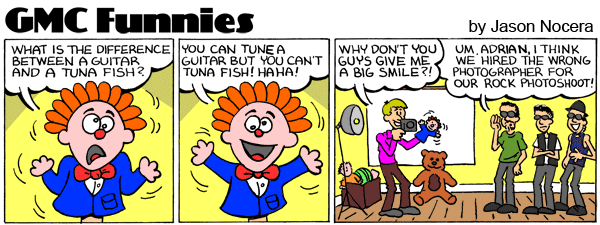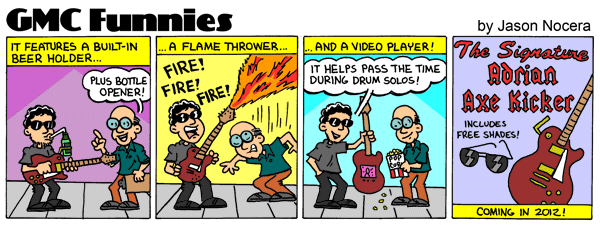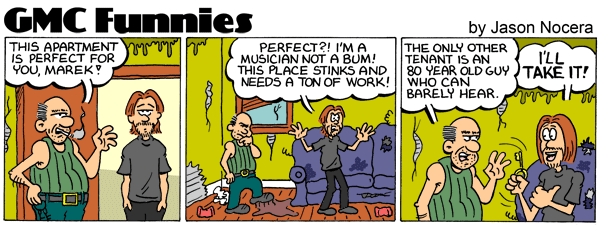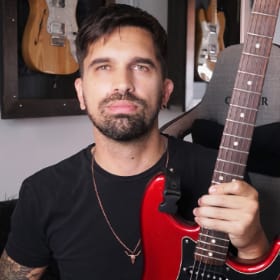Mixing Guitars |
|
|
|
|
|
| Jul 16 2011, 04:07 PM |
|
Lower the gain, record multiple tracks. Guitars/amps/amp settings can be vary from one another.
|
|
|
||
|
|
|
|
| Jul 16 2011, 04:32 PM |
|
Use best guitar available, and do your best with playing. Use less gain as Marek suggested, and record multiple tracks so you can pan them. Record as tight as possible.
When recording and not sure how it will turn out, make sure you don't use so extreme settings. In the case of heavy metal, this means don't scoop the mids too much. If you were on the gig, you would probably scoop it more, but in the studio, getting richer sound is more important. In that sense, make sure you play your guitar as loud as possible, to get the best possible tone. Forget about dynamics as on stage, in studio it's best to bang the guitar so you produce the tone and energy. Have fun, and make sure you get a positive attitude when coming into the studio. It's very important! -------------------- - Ivan's Video Chat Lesson Notes HERE
- Check out my GMC Profile and Lessons - (Please subscribe to my) YouTube Official Channel - Let's be connected through ! Facebook! :) |
|
|
||
|
|
|
|
| Jul 16 2011, 08:31 PM |
|
Hey guys i'm going into the studio next week for a couple of recordings for a heavy metal song. I need some suggestions about how to make rhythm guitar parts sound "BIG".....any specific recording or miking techniques? Oh and i also need some tips on making a guitar sound bigger during the mixing. I am most likely to use a Marshall MG half stack...thanks in advance =) All good guitar parts start with good clean tracking/recording. With regard to this you need to experiment with and get a good mic position and set up. You may well need to multi mic the guitar amp, with, for instance, a mic close to and pointing at the speaker cone and another set further back in the room and possibly one at the rear of the speaker cab. You should experiment a bit with different types and makes of mics as well. Personally I always like a Shure 57 at the speaker and a Neumann TLM or U series set back - the Neumann works particularly well if you can run it in to a good analogue preamp such as a Neve. Often a combination of a dynamic mic at the speaker cone and a condenser set back in the room work well. Placing a second mic a little back helps both thicken the tone and also captures some of the room's reverberation. If you multi mic pay attention to, and avoid, phasing. If you can use only one mic I'd use a good condenser (ie a Neumann) in to a good preamp and place it at the speaker. It has sufficient dynamic range so that it can handle the potential high SP levels and IMHO doesn't have the somewhat brittle and sharp quality of a dynamic. You need to ensure that you get a clean, strong signal that still has sufficient head room so that the track does not clip and also so that you can add effects etc to it at a later stage and combine it with other instrument and vocal tracks to produce the final stereo mixdown which again must not clip. You may well find that your guitar peak signal is likely to be @-12dBFS or lower to achieve this. Keep in mind that final volume is achieved and set at mastering NOT at recording or mixing. You might want to consider HPF'ing the rythym guitar at @90Hz to avoid unnecessary low end. Otherwise it's best to avoid adding any effects until you get to the mixing stage. As Ivan says use less gain than you would normally. To some extent it may well be worth recording completely clean and reamping for guitar distortion later as this will give you more scope to experiement. As to whether or not you record multiple takes for a wall of sound - that imho depends on the track and what you are trying to achieve. If you do follow Uncreator's advice but also experiement using the 80% position for hard L/R. This can lead in some instances to better stereo imaging and less mud. Also be aware of the panning law (which Uncreator suggests when he talks about setting the centre position volume lower than the sides) - you might want to have a look at how your DAW is set up vis a vis panning. Again if you want a wall of sound do the hard L/R with a slightly different mic set up and EQ to the centre as it can help the overall tone and spectral balance and give an impression of a thicker guitar tone. At mixing - experiement with EQ and compression. With EQ'ing you need to focus not just on how the guitar sounds by itself but also how well it sits with the other instruments and vocals. You may well find that you will need to attenuate low mid frequencies - particularly in the 2-400Hz range - to avoid a muddy mix. Also keep in mind that you will almost always get a better result by attenuating rather than boosting - and to this end you should get some experience of how adjustunments made at a particular part of the spectrum afects the overall perceived frequency balance. For isntance, if you want to brighten the high end instead of adding gain to the >5kHz end it is often better to do some attenuation in the 500-2000Hz mid band. To bring out the character and add some additional depth to the guitar identify the fundamental frequencies and instead of adding gain to them add it tat the 2nd and 3rd order harmonics. The fundamental is usually in the low mid band and if you boost it you will end up with mud, boosting the harmonic helps avoid this. Compression - for rock something like an API2500 compressor should work well. You will need to experiement with settings but you might find that a ratio of about 5:1 works well but also be prepared to experiemtn with the attack and release times. A single tracked guitar here can also be paralleled compressed to add weigth and body. Avoid placing a compressor on the 2 bus unless you are mixing in to it. Similarly try and avoid putting a limiter on the 2 bus - get your levels right and it isn't needed and once it's on it's very hard to remove. Reverb can add a little impression of depth and space but be very careful that you don't overdo it as reverb is very difficult to remove. Too much reverb can result in a poorly defined balance and a muddy mix. -------------------- Get your music professionally mastered by anl AES registered Mastering Engineer. Contact me for Audio Mastering Services and Advice and visit our website www.miromastering.com
Be friends on facebook with us here. We use professional, mastering grade hardware in our mastering studo. Our hardware includes: Cranesong Avocet II Monitor Controller, Dangerous Music Liasion Insert Hardware Router, ATC SCM Pro Monitors, Lavry Black DA11, Prism Orpheus ADC/DAC, Gyratec Gyraf XIV Parallel Passive Mastering EQ, Great River MAQ 2NV Mastering EQ, Kush Clariphonic Parallel EQ Shelf, Maselec MLA-2 Mastering Compressor, API 2500 Mastering Compressor, Eventide Eclipse Reverb/Echo. |
|
|
||
|
|
|
|
| Jul 17 2011, 10:15 AM |
|
Thanks a bunch tony, really appreciate it. This will definitely help a lot when i'm mixing. Unfortunately we don't have an API2500 compressor. All we have in the studio is a Solid state Logic x-rack stereo compressor and a DRAWMER DL 441. I do not have any plans of adding any sort of signal processors during the recording process. What about using a Sennheiser MD421 with a Neumann u87? Or maybe Neumann U87 and a Helisound PR-30? Would you recommend this combinations? And i will have another track recording the guitars through a Countryman DI box. Thanks Thanks a lot for the tip The SSL - I'm assuming it's the E series and not the G series 2bus module - should be ok albeit it may be a bit too clean and transparent for guitar. I like SSL comps but used to find them better on voc and some drums (but that was years ago on an old 9000 console and things may have changed in their design by now though). I kind of associate the SSL sound with the late 80s and 90s and if you're after a more 70s type sound it might be tricky to get. Regardless I'd probably opt for the SSL over the Drawmer, not least as it has attack and release whereas if I remember the Drawmer it's auto. Also I think the Drawmer doubles up as a comp/limiter and is VCA - if it is you might find that it starts to distort the waveform if you push it. If it's the SSL G series 2 bus - again I think it's better than the Drawmer but be very careful with anything you on the 2 bus. (Sorry if I sound like I'm negative about the Drawmer. It's fine for use, I just think the SSL is more versatile as the SSL has attack and release.) MD421 and U87 should be good. Never come across a Hellsound so I can't comment. Are you using an SSL for the preamps as you have an X rack? -------------------- Get your music professionally mastered by anl AES registered Mastering Engineer. Contact me for Audio Mastering Services and Advice and visit our website www.miromastering.com
Be friends on facebook with us here. We use professional, mastering grade hardware in our mastering studo. Our hardware includes: Cranesong Avocet II Monitor Controller, Dangerous Music Liasion Insert Hardware Router, ATC SCM Pro Monitors, Lavry Black DA11, Prism Orpheus ADC/DAC, Gyratec Gyraf XIV Parallel Passive Mastering EQ, Great River MAQ 2NV Mastering EQ, Kush Clariphonic Parallel EQ Shelf, Maselec MLA-2 Mastering Compressor, API 2500 Mastering Compressor, Eventide Eclipse Reverb/Echo. |
|
|
||
|
|
|
|
| Jul 17 2011, 08:14 PM |
|
play strong man, i mean, hit the strings with power ( not exagerately, of course) the actittude should be recorded in every take.
-------------------- WWW.GROOVERMETAL.COM.AR
|
|
|
||
|
|
|
|
| Jul 18 2011, 09:31 AM |
|
As far as mixing goes, it's best to leave it to the professional. Your role as a composer/arranger is such that you keep the arrangement interesting. Dynamics has to exist to allow the song to be alive. Adding some very simple elements is usually better than adding complicated arrangements. So, playing only pedal note here and there, dubbing fat downbeat riff only from time to time, or adding couple of notes here and there will all together sound complicated enough.
Don't worry about creating space in the mix during recording process, yes some cutting is needed (like tony suggested the hi-pass @ 90Hz on guitar track) but it's also important to provide as healthiest and richest recording available. This is one of the most important things when insisting on a "huge" sound. Having fat and rich sound depends on what you have in the mix. If you record rich, you'll have what to shape, if you record thin, you will hardly be able to "create" frequencies. -------------------- - Ivan's Video Chat Lesson Notes HERE
- Check out my GMC Profile and Lessons - (Please subscribe to my) YouTube Official Channel - Let's be connected through ! Facebook! :) |
|
|
||
|
|
|
|
| Jul 19 2011, 06:38 AM |
|
After these great posts I think that there is nothing to add... Tony explained perfectly every aspect to get awesome guitars. I've used many mics for recording a guitar but I rarely used one of them to capture the room reverberations... it doesn't worked for me in the mix the few times that I tried it.. do you have any suggestions Tony? What would add a ambient mic to these guitars for example?
-------------------- My lessons
Do you need a Guitar Plan? Join Gab's Army Check my band:Cirse Check my soundcloud:Soundcloud Please subscribe to my:Youtube Channel |
|
|
||
|
|
|
|
| Jul 19 2011, 11:02 AM |
|
...It's just that this is an assignment that i'm doing, which is to compose a song, record and also mix and master it at the end all by ourselves. ... IMHO as an assignment they should stipulate that mastering more often than not is best done in a specialised mastering studio by someone who was not involved in recording and mixing. Mastering is much more about critical objectivity than about the processing. If you recorded and mixed the take it is unlikely that you will have sufficient objectivity to critically listen to and correct your mix as most people like to think that their mix is already 'perfect'. Additionally, many mix issues are down to the studio monitoring and acoustics. Quite simply you can not correct what you can not hear accurately. Mastering studios and monitors are acoustically different to mix studios not least as a mastering studio is set up to be as accurate as possible rather than musically flattering. Gab - it's not easy to tell from a Youtube video but what a room mic will or should help add is a sense of front to back stereo depth. A close mic generally doesn't provide enough distance from source to mic to allow it to pick up reflections, whereas a mic set further back can and does. It 's these reflections that help here. How well it does this depends on placement and the room. Placement here is both dependent on distance from the source and any reflective surfaces including corners. This isn't however just about reverb but also about the low end frequencies. The low end usually benefits from reflection much more than the high frequencies because of the very slight time difference betwen the direct and the reflected signals. It's this that helps give a sense of front to back depth and sadly it seems to be something that a lot of modern recordings miss out: they pay attention to the width of the stereo field left to right but not the stereo depth and as a result far too often the music lacks spatial depth. Spatial depth is a big reason why many orchestras are recorded using a relatively simple three mic arrangement, with the mics at close, middle and far distance. It helps the listener locate where the instruments are in the orchestra so that they can clearly hear, for instance, that the 2nd violin section is behind and to the left of the 1st and infrot of the woodwind, rather than merely a little to the left of the 1st and standing with the woodwind. WRT reverb - rooms all have different reverb characteristics depending on size, shape and constuction. It may be that your studio is treated to significantly reduce reflections and if so that would result in a space with little reverb. Many studios are often deliberately dry as it can often be better to record dry as reverb is extremely hard to remove once its there. A dry room lets you chose if you want to add reverb at mixing and also chose the type of reverb. One potential issue is recording in a wet room and adding yet more, and different, reverb at mixing is that it will end in an ill defined mess. Nonetheless just in the context of getting a fuller guitar at recording mic'ing so that you pick up natural room ambience can help - just so long as your careful that it's not overdone -------------------- Get your music professionally mastered by anl AES registered Mastering Engineer. Contact me for Audio Mastering Services and Advice and visit our website www.miromastering.com
Be friends on facebook with us here. We use professional, mastering grade hardware in our mastering studo. Our hardware includes: Cranesong Avocet II Monitor Controller, Dangerous Music Liasion Insert Hardware Router, ATC SCM Pro Monitors, Lavry Black DA11, Prism Orpheus ADC/DAC, Gyratec Gyraf XIV Parallel Passive Mastering EQ, Great River MAQ 2NV Mastering EQ, Kush Clariphonic Parallel EQ Shelf, Maselec MLA-2 Mastering Compressor, API 2500 Mastering Compressor, Eventide Eclipse Reverb/Echo. |
|
|
||
|
|
|
|
| Jul 19 2011, 03:32 PM |
|
my two cents, play all the doubled takes as close as you can to the original, they would NEVER sound the same to get phase problems, but if they tend to sound heavier if you play them close together, at least thats what my ears like
--------------------  Check my Instructor Profile Rockers! Got a Blog too!, www.adriantracks.com Follow me on facebook and youtube! -Youtube   |
|
|
||
|
|
|
|
| Jul 21 2011, 06:43 PM |
|
IMHO as an assignment they should stipulate that mastering more often than not is best done in a specialised mastering studio by someone who was not involved in recording and mixing. Mastering is much more about critical objectivity than about the processing. If you recorded and mixed the take it is unlikely that you will have sufficient objectivity to critically listen to and correct your mix as most people like to think that their mix is already 'perfect'. Additionally, many mix issues are down to the studio monitoring and acoustics. Quite simply you can not correct what you can not hear accurately. Mastering studios and monitors are acoustically different to mix studios not least as a mastering studio is set up to be as accurate as possible rather than musically flattering. Gab - it's not easy to tell from a Youtube video but what a room mic will or should help add is a sense of front to back stereo depth. A close mic generally doesn't provide enough distance from source to mic to allow it to pick up reflections, whereas a mic set further back can and does. It 's these reflections that help here. How well it does this depends on placement and the room. Placement here is both dependent on distance from the source and any reflective surfaces including corners. This isn't however just about reverb but also about the low end frequencies. The low end usually benefits from reflection much more than the high frequencies because of the very slight time difference betwen the direct and the reflected signals. It's this that helps give a sense of front to back depth and sadly it seems to be something that a lot of modern recordings miss out: they pay attention to the width of the stereo field left to right but not the stereo depth and as a result far too often the music lacks spatial depth. Spatial depth is a big reason why many orchestras are recorded using a relatively simple three mic arrangement, with the mics at close, middle and far distance. It helps the listener locate where the instruments are in the orchestra so that they can clearly hear, for instance, that the 2nd violin section is behind and to the left of the 1st and infrot of the woodwind, rather than merely a little to the left of the 1st and standing with the woodwind. WRT reverb - rooms all have different reverb characteristics depending on size, shape and constuction. It may be that your studio is treated to significantly reduce reflections and if so that would result in a space with little reverb. Many studios are often deliberately dry as it can often be better to record dry as reverb is extremely hard to remove once its there. A dry room lets you chose if you want to add reverb at mixing and also chose the type of reverb. One potential issue is recording in a wet room and adding yet more, and different, reverb at mixing is that it will end in an ill defined mess. Nonetheless just in the context of getting a fuller guitar at recording mic'ing so that you pick up natural room ambience can help - just so long as your careful that it's not overdone Thanks for clarifying Tony. My recording room isn't too big so the reverb that I could get is little, however I will experiment with this... -------------------- My lessons
Do you need a Guitar Plan? Join Gab's Army Check my band:Cirse Check my soundcloud:Soundcloud Please subscribe to my:Youtube Channel |
|
|
||
1 User(s) are reading this topic (1 Guests and 0 Anonymous Users)
0 Members:

































